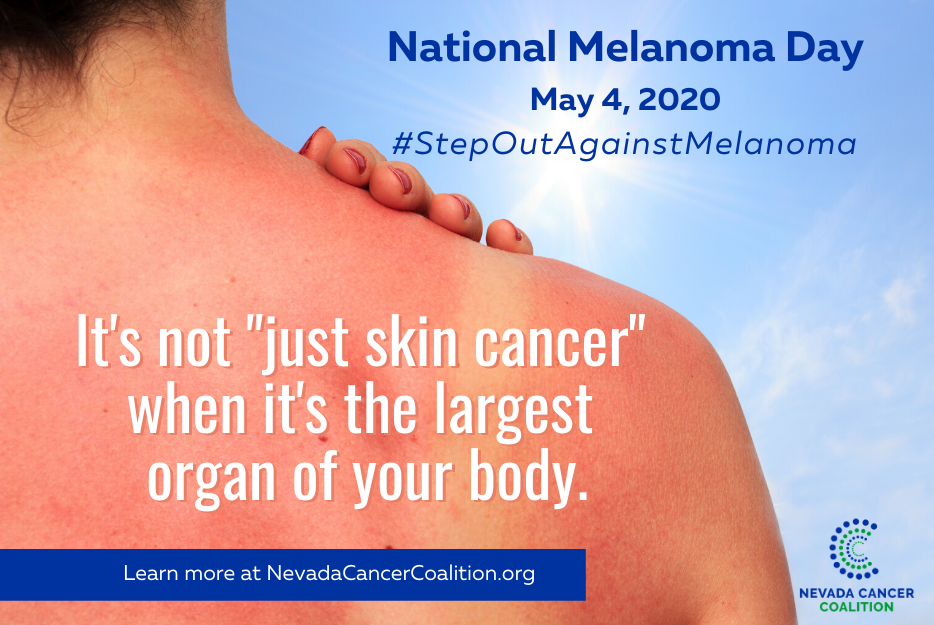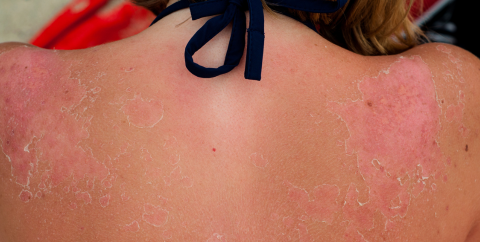Cover Up! It's Skin Cancer Detection & Prevention Month
05 May, 2014
Each year the month of May is designated National Melanoma/Skin Cancer Detection and Prevention Month. NCC's intern project assistant Ashley Davis has focused on skin cancer prevention and Nevada's 2013 tanning legislation for the spring semester leading up to this awareness month. This week she guest blogs for us on skin cancer prevention and detection. Skin cancer, including melanoma, is currently the most common form of cancer in the nation with more than two million being diagnosed every year and one person dying every hour in the United States. Although the survival rate for melanoma is higher than most other serious cancers, the mortality rates are still on the rise. There are two major groups of skin cancer: non-melanoma and melanoma. Basal cell carcinoma is a type of non-melanoma skin cancer and is the most common form of cancer in the United States. According to the American Cancer Society, 75% of all skin cancers are basal cell carcinomas.

Superficial spreading malignant melanoma. Note the roughened edges of this mole, its heterogeneous, mottled, multicolored appearance, as well as its multi-textural composition, which are all characteristics that should evoke suspicions about its classification. An important feature here, is the single, large nodule, around which this pigmented patch arose, which is one of the characteristics of this form of melanoma.[/caption]
Early Detection
As with many of the top cancer killers, prevention and early detection are key to reducing mortality rates. We’ll get to prevention in a bit, but let’s start with early detection and regular skin checks. You can do this yourself, or get a friend or family member to help you check your back and other hard to see areas like the backs of your legs and neck. It’s as simple as looking for ABCDE: A- Asymmetry – If you were to draw a line through the mole, the two halves would not match. B- Border- The border is uneven and may be notched or scalloped. C- Color- The mole will have a variety of different shades. Including black, tan, brown, red and sometimes blue. D- Diameter- The mole is larger than ¼ inch. A good method of judging would be comparing it to an eraser tip. E- Evolving- A change in size, color, shape or any other trait in the mole. New symptoms such as itchiness or bleeding are included. If you spot any of these be sure to see a dermatologist for further examination and perhaps a removal and biopsy. While the U.S. Preventive Services Task Force has concluded that the current evidence is insufficient to assess the balance of benefits and harms of regular skin cancer screening by a physician, those with more sun-sensitive skin or exposure to the sun may choose to schedule annual or bi-annual skin checks with their physician.
Treatment
Treatments for skin cancer vary with the severity of the mole. As with staging other cancers, there are five stages when it comes to diagnosing melanoma and you must visit a specialist to determine the stage. Treatments can be as simple as removal of the mole and/or applying topical creams to radiation and chemotherapy if the cancer has progressed further.
Prevention
Skin cancer risk can be lowered greatly by taking these easy and simple to follow steps:
Apply sunscreen DAILY. The sun comes up everyday which means you should put on sunscreen every day, even if it’s a cloudy day. Anywhere from 70-80% of UV rays can travel through the clouds. A recommended amount of SPF that should be used daily is no less than 15. Remember to get your ears, the back of your neck, exposed areas of your scalp which may be forgotten.
Look for the shade. During the hottest time of the day, roughly 10:00 am and 4:00 pm, it is crucial to stay out of the sun for as long as possible. It is very easy to get sun burned if you’re not wearing proper protection during these hours.
Wear proper clothing. Densely woven or darker fabrics protect against the sun better than plain white T-shirts. Long sleeved shirts and full length pants are preferable for those being exposed for an extended period of time. Sunglasses are great to keep the harmful UV rays out of your eyes however, make sure they aren’t reflective or mirrored. Sunglasses that are reflective will actually bounce those rays on your face. In addition to these, hats are a great way to keep the rays out of your face and scalp.
You May Also Like

Fall into Sun Safety: Why Wide-Brimmed Hats and Sunscreen Are Autumn Essentials
11.04.2024
As the leaves begin to change and temperatures cool, it's easy to forget about sun protection.

Skin cancer continues to be most common cancer in Nevada, U.S.
05.01.2023
More people are diagnosed with skin cancer each year in Nevada than all other cancers combined, according to the American Can

Skin cancer continues to be most common cancer in Nevada, U.S.
05.01.2023
More people are diagnosed with skin cancer each year in Nevada than all other cancers combined, according to the American Can